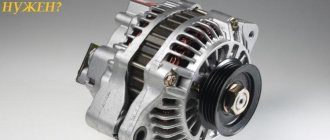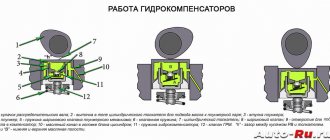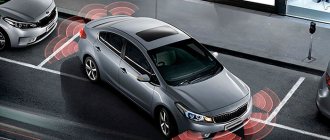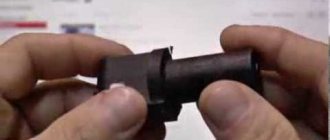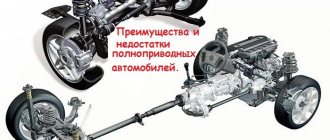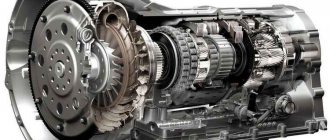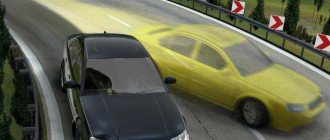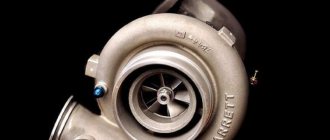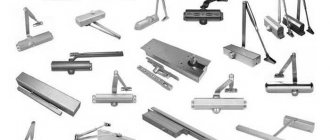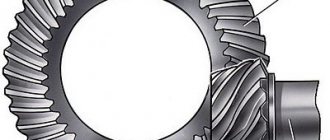Hello dear readers of my blog. In this article I will introduce you to a very important system that is found in every modern vehicle. This is the ABC or anti-lock braking system. What is ABS in a car? Simply put, this is a set of devices that, during braking, despite the actions of the driver, prevent wheel locking.
Why is this necessary? Everything is explained very simply. If the driver presses the brake pedal, the car slows down. However, if you need to stop immediately, pressing the pedal sharply causes the locked wheels to slip. At this time the car is uncontrollable. But, a car equipped with an ABC system will not move with non-rotating wheels during an emergency stop; it will maintain control and stability on the roadway. This means that you can easily go around any obstacle, and during braking you will not get into a skid on a slippery turn.
A little history
You might think that the ABS system is a recent invention. But it appeared back in 1978 and has undergone many changes and improvements to this day. In 1985, ABS was integrated into the traction control system, and since 2004, every car produced in Europe must be equipped with this development.
You've probably heard of Bosch. She is the leader in ABC production. The most modern system weighs approximately 1 kg. Its advantage is that you can buy an ABC unit and install it in the standard braking system of the vehicle without making any changes to it.
Story
For the first time, the problem of wheel locking during braking was discovered on a railway vehicle, since blocked wheels have a significantly less braking effect, and a wear appears on the wheel rim, which reduces the driving performance of the car or locomotive. In addition, when the wheel pairs are locked, the likelihood of derailment increases significantly. The problem was solved by the use of automatic brake force regulators, known today as cargo auto mode. On electric trains and trams, where service braking is electric, wheel locking is prevented by electrical and electronic systems that automatically regulate the excitation current of traction motors operating in generator mode during braking. Such systems have been known since the 1920s. Also in the 1920s, the first ABS appeared for installation on aircraft landing gear. Here it was necessary to solve the problem of aircraft controllability when running along the runway. The first products were created by the French company Avions Voisin, a manufacturer of automobiles and aircraft[1].
In those days, most cars had mechanical brakes with a cable drive and required significant physical strength from the driver, in other words, you had to press hard on the brake pedal, thereby causing the wheels to lock, which, in turn, negatively affected the car's handling. Later, hydraulic brakes with a vacuum booster appeared, but this system did not solve the problem of wheel locking.
In 1936, Bosch patented technology to prevent wheel locking during heavy braking. But in practice, it was not possible to implement this idea due to the lack of digital electronics in those years, which would allow reacting to wheel locking in a split second. The situation changed in the 1960s with the advent of semiconductor technology, which gradually reached the automotive industry. But the first samples of ABS, which appeared in 1971 on one of the models of the General Motors concern, turned out to be even dangerous, since they did not solve the problem of jamming of the front drive wheels.
The first truly functional ABS was invented by the Germans. In addition to Bosch, Teldix GmbH began work on the creation of ABS in 1964. Its engineer Heinz Lieber developed the fundamental principles of the future ABS. Later, he headed the electrical and electronics department of the Daimler-Benz concern and in 1970, Daimler-Benz solemnly announced the creation of the first functional ABS. The system, called "ABS 1", consisted of an electronic controller, speed sensors mounted on each wheel, and two or more hydraulic valves in the brake circuit. The system worked from data on the difference in rotation speeds of different wheels: if they rotated at different speeds, the controller, dosing the braking force, equalized the rotation speed. After this, the system made it possible to increase the braking force[1].
Comprehensive tests of this system revealed one significant drawback - the unreliability of electronic components. At the suggestion of Daimler-Benz, Bosch engineers were involved in the project, who worked independently of Lieber and gained extensive experience in the field of automotive electronics.
Thus, to create a serial anti-lock braking system, Lieber’s successful ideas and the vast experience of Bosch engineers in the development and production of digital electronic components were combined. In the mid-1970s, ABS began to be installed optionally (at the request of the client and for an additional fee) on luxury cars, and since 1978, as standard on two German cars - Mercedes Benz W116 (S-class)[1] and BMW 7th series, and the cost of the system at that time was approximately 10% of the cost of the entire car[2]. Since July 2004, every new car sold in the European Union must be equipped with ABS as standard.
The most effective ABS
Nowadays, the 4-channel anti-lock braking system works most effectively. The advantage here is that it is able to individually regulate the slip of each wheel. If your car is equipped with such an ABS, you can consider yourself lucky, because individual adjustment ensures optimal braking torque for each wheel, taking into account the conditions on the road. As a result, the braking distance will be minimal.
Tasks performed by ABS
Braking distances
Thus, the anti-lock braking system performs a number of very important tasks:
- ensures safety when braking, both for the driver and his passengers;
- reduces braking distance on slippery or wet road surfaces;
- does not allow the drive wheels to lock during sudden braking, which makes it possible to maneuver and avoid the obstacle that has arisen.
In some cases, the use of ABS is not justified. Thus, when driving down a steep slope in heavy snow or muddy swamp conditions, turning on the anti-lock braking system can lead to dire consequences. Due to gravity, the car rolls down, while ABS does not allow the wheels to lock, and therefore the car, although slowly, still continues to move forward even with the brake pedal fully depressed.
Indicator
Despite the fact that such situations are extremely rare, all modern SUVs are equipped with additional sensors that determine the degree of inclination of the road track. If the descent is too steep, the anti-lock system becomes inactive.
ABS construction
Let's now see what technological solutions are included in the ABS. A modern anti-blocking system consists of:
- wheel speed sensors;
- pressure sensors in the brake system;
- hydraulic unit (actuator);
- control units.
Each wheel is equipped with a speed sensor. The rotation speed values recorded by it in the form of electrical pulses are transmitted to the control unit, which, using special programs, generates control signals. By accepting them, the actuators control the braking process.
How the anti-lock braking system works
To make a decision and execute it, any automation must have an input signal, a data processing device and actuators.
Likewise, ABS, receiving a signal that the wheels have begun to lock, briefly releases the brakes on the disc or drum associated with the hub, and after contact is restored, it again applies pressure to the brake pads. The process is repeated dozens of times per second, which, as a result of averaging the pulse effect, gives the optimal deceleration value.
By monitoring the speed of the car and the frequency of rotation of the wheels, the system compares these values, trying not to go beyond the specified limits of the difference between them.
In this way, deceleration is maintained at the maximum possible for the given road conditions. In other cases, when there is enough clutch for the desired braking, ABS is “silent” without interfering with control.
Features of the system
While the ABS is operating, you will feel impulses and shocks on the brake pedal. This is all normal, as is the ratcheting sound. But always remember that the serviceability of the system is determined by the “ABC” indicator light. When the ignition is turned on, it lights up, and 2-3 seconds after starting the engine it goes out.
Also keep in mind that if your car is equipped with ABS, it will brake abruptly and repeatedly. When braking, always keep the pedal pressed firmly. This is the only way the system can provide the shortest braking distance.
If the road surface is dry, ABC will allow your car to reduce braking distance by 20% compared to a car whose wheels are locked. And if you drive on wet asphalt covered with snow or ice, the difference will be significantly greater.
What is the ABS system and how does it work
Why do we need electronics in wheels?
...In the evening I park the car. I see in the next section several gentlemen drinking whiskey on the hood of a brand new car. Apparently, the middle stage of the ritual of washing a purchase. Of course, an invitation followed. Of course, I couldn't refuse. To begin with, the beaming owner “introduced” the car to me. Eight cylinders, four or two liters of volume, ABS... The evil one pulled me to ask why he needed the latter. Here a shadow of doubt crossed the happy man’s face, then a curtain of sadness covered him. “ABS… shortens the braking distance,” he muttered. That's all?! I was horrified by the illiteracy of the wealthy working masses and took up the pen.
ABS stands for Anti-Lock Braking System . Its job is to prevent the wheels from locking when braking. Why is this necessary? A car with locked wheels turns into an uncontrollable mountain of iron. No matter how you turn the steering wheel, it will fly forward by inertia. But when the wheels roll (ABS provides them with this opportunity), the car normally obeys the steering wheel.
Now let's imagine a banal situation. Suddenly, a dog jumped out onto the road and froze in amazement when he saw a car flying towards him. Most drivers will press the brakes as hard as they can in this case. This is a completely natural reflex and there is no escape from it. If there is no ABS, then the dog’s life depends on whether the car has time to stop or not (after all, it is impossible to drive around the dog when the wheels are blocked). What would a very experienced driver, of whom there are very few among us, act? He has a special quick braking reflex: his foot doesn’t just press the pedal, it pulsates on the pedal. It is this intermittent braking that prevents the wheels from locking. And an experienced driver will not only stop the car, but also drive around the ill-fated dog. In such situations, ABS simply imitates the actions of an ace, providing intermittent braking (and the actions of a fantastic super-ace - a normal person physically cannot press and release the brake about 20 times in one second). And then the driver of any qualification remains able to steer the car.
The above situation is ideal. In reality, this does not happen. After all, the road is uneven. It may be covered with puddles, ice stains, oil streaks, and alternating areas of dry asphalt. If a car brakes without ABS, with each change of surface it veers slightly to the side, trying to slip into a skid. Why? I'll explain now. Imagine that you are skating on ice and suddenly there is clean asphalt under your right skate. What will happen? That's right, you will be jerked (read, skidded) to the right, and the matter will most likely end in a fall. A car with ABS is not afraid of uneven roads. When braking, it will pass a piece of asphalt, an ice spot and an oil slick, without ever losing its course. The driver can only monitor the trajectory, and not fight the resulting drifts. So, the main task of ABS is to ensure safety during braking. Maintain trajectory stability. Allow the driver to operate the steering wheel.
Some motorists snort contemptuously when it comes to ABS. They say that a good driver doesn’t need it, it’s not for nothing that athletes turn it off when rebuilding a production car into a rally car. I usually ask such “experts”: do you often use braking with your left foot? Usually they don't even know what it is. And you, dear readers, I won’t bother you with all sorts of sports wisdom either. Yes, ABS interferes with the performance of some specific techniques from the arsenal of racing drivers. So what?.. After all, no one criticizes the Hugo Boss suits because it is dangerous and inconvenient to climb Elbrus in them.
The common belief that ABS shortens braking distances is not entirely correct. Yes, on wet or slippery roads it slightly reduces the braking distance. On clean asphalt, a car without ABS will most likely stop a little faster. And finally, ABS is simply dangerous on very steep snowy or muddy slopes. In such cases, gravity pulls the car down the road, the ABS prevents the wheels from locking, and therefore the car slowly rolls forward. The situation is rare, but most dangerous. Therefore, some SUV models are equipped with sensors that determine the degree of slope. If the descent is too steep, the ABS is automatically switched off.
How to use ABS correctly?
So, you probably already understand what ABC is in a car. Now let's move on to practical advice. Modern systems are highly reliable, and if you install one of them on your car, it will work for a long time and reliably. Failures here are extremely rare, this is facilitated by fuses or relays. But if the ABC still malfunctions, then most likely the reason lies in violations of the rules of use. Therefore, before you get behind the wheel of a modern car, you need to understand the rules and recommendations for using the anti-lock braking system.
What do you think is the most vulnerable point of the ABS? If you answer - wheel sensors, then you will guess. And the reason for the vulnerability is hidden in their poor placement: near axle shafts, hubs and rotating parts. Sensors may refuse to work due to contamination and large play in the hub bearings. This is sometimes caused by replacing the ABC sensor. But this is not all the problems. If the voltage between the battery terminals is below 10.5 V, the fuse box can independently turn off the ABC. The system will also shut down if voltage spikes or unacceptable fluctuations are detected in the vehicle's network.
You can avoid these troubles by following simple rules.
- Do not disconnect electrical connectors while the ignition is on or the engine is running.
- Do not start the engine using the “lighting” method from another battery and do not provide such services.
- Watch the contact connections on the generator.
Device
The system includes electronic, mechanical and hydraulic components that are seamlessly integrated into traditional brakes. Everything is done so that if elements related to ABS fail, the braking functionality does not change.
Speed sensors
Theoretically, the most capable system would have five of them, one measuring the speed of the vehicle as a whole, the others monitoring the rotational speed of each wheel, which is related to the linear speed of the tire tread. Both the difference in speeds and the dynamics of their change are subject to assessment.
Each sensor is an electromagnet, including a core and an inductor wound around it. The unit is attached to the suspension knuckle or axle shaft, and its protruding tip with a small gap monitors the rotation of the drive disk connected to the wheel hub.
Sometimes this is a ring gear, sometimes it is simply a component of a wheel bearing magnetized in short sections. There are also devices based on the Hall effect; they are faster, although there is no particular need for this.
This is interesting: What is the difference between a crossover, SUV and SUV
At the output of the sensor, a pulsed electrical signal is generated, each peak of which corresponds to one tooth or magnetic mark. The frequency of these pulses is proportional to the speed of rotation of the wheel.
The signal is transmitted via a shielded cable to the ABS control unit, where it is amplified and converted into digital format. The unit continuously monitors the received data, taking it as information about the instantaneous speed of rotation of the wheels.
Valves
To carry out commands from the electronic unit to change the pressure in the brake lines, devices are needed that convert electrical signals into hydraulic power signals.
Control valves play this role. They are classic solenoids, the rods of which are connected to normally closed or open hydraulic locking cones.
As a rule, two valves are installed per wheel, a normally open (that is, not impeding the flow in the absence of control voltage) inlet and a normally closed outlet. The first one applies pressure to the brake working cylinder, the second one releases it.
There are three modes of valve operation:
- supplying pressure to the cylinder, the first is open, the second is closed;
- holding pressure when both valves are closed is triggered at the first sign of slipping;
- pressure release, the release valve opens, if holding did not help and the wheel continues to slide.
The valves must have good response speed, since the process occurs at a high frequency for high-quality braking modulation.
Pump
The system includes an electric working fluid pump, whose role is to accelerate pumping, which increases the overall performance of the ABS. The higher the operating pressure, the sooner the system will respond to any mode.
Peak loads and pressure pulsations are eliminated using hydraulic accumulators interlocked with the pump, which smooth out fluctuations and store a supply of liquid that has energy due to the compressed accumulator spring located on the reverse side of its diaphragm. Power is supplied to the pump at the command of the control unit.
Control block
An electronic module, built on the basis of a microcomputer, is the brain of the system, collecting information from all sensors, as well as via the interface bus from other car computers, and storing in memory all the ABS operating algorithms in the form of a program.
The output signals of the unit are the supply voltage of the sensors, the pump, as well as turning on the malfunction indicator lamp, and transmitting information to other devices.
Control units are constantly being improved, their speed, ability to process large volumes of information, and the efficiency of using new algorithms are increasing.
You need to know this: What are ESP and EBD in a car
Cars often find themselves in conditions where the simplest ways to control the wheels are not enough, and elements of artificial intelligence have to be introduced. Perfection has not yet been achieved. At the same time, new functions are added to the block that are not directly related to the ABS.
ABS fault signal
The manufacturers took care of everything. If the ABC fails, you will certainly know about it. The warning light on the instrument panel will light up. But don't worry. After all, turning off the anti-lock braking system does not mean that you are left without brakes. However, during braking the car will behave like a normal one.
The light bulb may also come on and off. This indicates that the ABC electrical circuit contact is not working properly. In this case, you will have to carefully inspect the wires and clean the contacts. But if these actions do not bring results, you will have to visit a specialized car service.
Remember also that servicing the brake system of a car equipped with ABS has a number of features. For example, before replacing the brake fluid, you will have to discharge the pressure accumulator in the valve body of the anti-lock braking system. This can be done by pressing the brake pedal twenty times with the ignition on.
Brake Assist
The Emergency Brake Assist System (EBAS) detects emergency braking, increases the pressure in the brake system to maximum and maintains it until the vehicle comes to a complete stop. SPET can be implemented using electronic components or hydraulics. When detecting emergency braking, the following are taken into account:
- current vehicle speed;
- speed of pressing the brake pedal;
- force (depth) of squeezing the brake pedal;
- distance to the vehicle in front;
- and other parameters (for example, proximity to traffic lights).
Studies have shown that a significant proportion of drivers in an emergency either do not press the brake pedal all the way or release it at some point. Because of this, the braking distance is longer than it could be with the pedal fully depressed. SPET was developed to solve this problem.
SPET first appeared on the consumer market in 1994 on the Audi A6 C4 under the name “Brake assist”. Following Audi, companies such as Volkswagen, Mercedes, Acura, Infiniti, BMW, Citroen, Rolls-Royce, Land Rover and Volvo offered their own developments.
The appearance of SPET became possible only after the advent of ABS. Since SPET always increases the braking force to maximum, in conditions of insufficient traction, the wheels may lock and the vehicle may slide; ABS prevents this.
Safety level with ABS
Still, no matter how reliable the modern anti-lock braking system is, the driver will always remain the main one. Safety depends largely on you. According to experts, ABC creates the illusion of safety. This mechanism is able to effectively prevent brake locking and provides control over steering and directional stability. But there is still no complete guarantee of reducing the braking distance. So always use your best skill and control in any situation and let the ABS do its part.
Well, that's probably all. Much more can be said about the anti-lock wheel system, but this is already a matter of narrow specialization. You should first know the main things listed above.
A modern car is a complex mechanism. It is filled with many unique technical solutions. In this article you learned about only one of his many systems, albeit a very important one. But as you travel through the pages of my blog, you will discover other secrets. Here you can find valuable recommendations from experts and my personal discoveries.
What is ABS? How does ABS work?
Braking in time is one of the main actions when driving a car.
Sometimes emergency braking saves the life of the car driver and other road users. The anti-lock braking system is designed specifically for such cases. Thanks to ABS, the car can be controlled. Uncontrolled movement on locked wheels (skidding) is not allowed. The absence of ABS when braking contributes to wheel locking and deprives the driver of the ability to maneuver. Not all drivers can instantly switch from braking to activating the steering wheel and vice versa. ABS performs such manipulations with car control at a speed of 15 times/sec, while reducing the braking distance.
What does the ABS system consist of?
ABS contains: speed sensors installed on the wheels of the car; control valves that are installed in the main brake system; a control unit that controls the operation of the valves using sensor signals.
During braking, ABS senses the speed at which each wheel is spinning. If one of the wheels slows down, resulting in a risk of blocking, then the valve, which is located in the line of the braking system, immediately reduces the braking force on that wheel. When the rotation of this wheel becomes faster than the rotation of the other wheels, the braking force stabilizes. This process happens repeatedly. This causes the brake pedal to pulsate. The driver, having felt the pulsation under his foot, always has the opportunity to note the moment the ABS begins to operate.
Anti-lock braking systems can be single-channel, dual-channel or multi-channel. The former are good when all wheels have approximately equal grip on the road surface. But if the surface on which the Kia Sorento is moving is not uniform, or one wheel is on a patch of ice, a roadside or a puddle, then multi-channel ABS will work more effectively.
Disadvantages of ABS
But ABS also has its disadvantages. In inexpensive car models, braking on ice, loose soil and sand is difficult. In modern cars, electric brake mechanisms are popular, which operate independently on each wheel. In these cases, ABS does not affect the brake pedal or handle.
It is worth noting that in the event of an ABS malfunction and repair, the matter usually comes down to replacing the ABS control unit. The AutoSTim technical center provides services for identifying faults in the brake system and eliminating them.
- < Back
- Forward >
